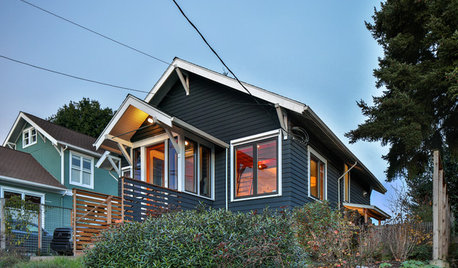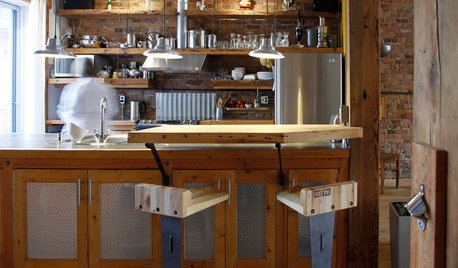Hood - baffles or mesh (or Ventahood)?
caliente63
11 years ago
Featured Answer
Sort by:Oldest
Comments (20)
deeageaux
11 years agobadgergal
11 years agoRelated Discussions
Baffles, Mesh, Both and Best
Comments (14)Mls99 - yes, the squirrel cage or "Magic Lung" that VAH uses is an alternative to both mesh or baffle. I have the VAH, and really like it. It just makes logical sense to me. There should be less noise due to less air turbulence that occurs when air goes in and out of baffles and mesh. In any case, Cfm's are all relative to your ducting - the manufacturer can cite, e.g., 900 cfm's till the cows come home, but if your ducts have a long run, a lot of turns, or are too narrow, the spec'd 900 will definitely NOT be there. Setting aside VAH, and just deciding between mesh and baffles, I'd choose baffles over mesh any day. I used to have a hood with mesh filters and it was a poor performer. The mesh got clogged easily, often with just one meal, and was just kinda gross. Also, you would never find a mesh filter hood in a restaurant kitchen due to its inefficiency. In case you haven't seen it, I am linking below the Appliances Forum FAQ on Vent Hoods. Here is a link that might be useful: Appliances Forum FAQ on Vent Hoods...See MorePRXH18-M30 Vent-A-Hood M Series with Baffles
Comments (7)I have a Rangecraft hood with baffles (my first real hood ever) over a CC rangetop. The baffles have never leaked. There is no trap or grease cup to hold gunk (I could never figure out why VAH thinks that's a good design). My baffles hold any grease or oil or whathaveyou until I take them out and throw them in the DW. I used to run them through the DW every week or so but have been forgetting lately due to the fact that I run a full DW twice a day and usually don't have room. Even washing them once a month like I've been doing is fine. The baffles never drip anything on the floor counter when removing them and putting them in the DW. It's so incredibly easy to clean baffles....See MoreVentahood M Line w baffles
Comments (9)I have cleaned both types of hoods over the years. The magic lung is not that bad. The inside of the canopy is something you see all of the time so it is there to "remind" you that it is there for cleaning so if you keep up on it it is not that bad. The baffle system is a lot worse it think because there is a opening behind the filters so you do not see it so it goes longer before you notice it needs to be cleaned. The baffle filters do not trap all of the grease so there is a good amount of grease that gets up inside the canopy behind the filters. Generally there is a smaller opening that you will have to reach through to clean behind the filters. The worst thing is that the grease gets on the blower motor and the wires so it cuts down the life of the motor. Vent a Hood has a new easy clean grease tray that looks like it is a lot better for cleaning....See MoreBest Potenza CP57E hood- hybrid mesh or stainless steel baffles?
Comments (2)For anyone who is interested- Best/Broan got back to me and said that the engineers confirmed that these units will come only with the Hybrid Mesh Filters....See Morecaliente63
11 years agocooksnsews
11 years agobadgergal
11 years agokaseki
11 years agocaliente63
11 years agokaseki
11 years agobreezygirl
11 years agokaseki
11 years agolwerner
11 years agokaseki
11 years agosanjayradia
5 years agokaseki
5 years agolast modified: 5 years agovinmarks
5 years agoD Scott
3 years agodlm19
2 months agokaseki
2 months agolast modified: 2 months agodlm19
2 months ago
Related Stories

KITCHEN DESIGNHow to Choose the Right Hood Fan for Your Kitchen
Keep your kitchen clean and your home's air fresh by understanding all the options for ventilating via a hood fan
Full Story
KITCHEN DESIGNWhat to Know When Choosing a Range Hood
Find out the types of kitchen range hoods available and the options for customized units
Full Story
KITCHEN APPLIANCESWhat to Consider When Adding a Range Hood
Get to know the types, styles and why you may want to skip a hood altogether
Full Story
KITCHEN DESIGNKitchen of the Week: Pushing Boundaries in a San Francisco Victorian
If the roll-up garage door doesn’t clue you in, the blue cabinets and oversize molding will: This kitchen is no ordinary Victorian galley
Full Story
MODERN HOMESHouzz TV: Seattle Family Almost Doubles Its Space Without Adding On
See how 2 work-from-home architects design and build an adaptable space for their family and business
Full Story
KITCHEN OF THE WEEKKitchen of the Week: What’s Old Is New Again in Texas
A fresh update brings back a 1920s kitchen’s original cottage style
Full Story
KITCHEN DESIGNPersonal Style: 50 Clever Real-Life Kitchen Design Details
Get ideas from savvy homeowners who have a knack for creating kitchens celebrating personal style
Full Story
CONTEMPORARY HOMESHouzz Tour: Warm Touches for a House of Grand Proportions
Scandinavian influences ensure character, functionality and easy maintenance in a large family home
Full StorySponsored
Custom Craftsmanship & Construction Solutions in Franklin County




lwerner